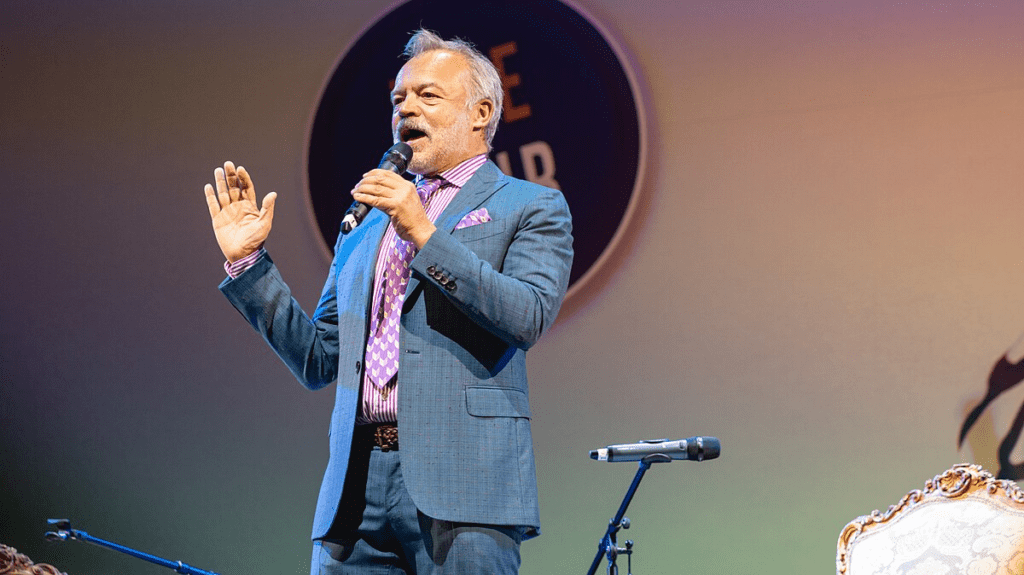Fans of the Graham Norton Show were quick to type to voice their opinions when pop star Pharrell Williams added his name to the guest list for the show, sporting a baseball cap and a pair of sunglasses – although the views were very vocal. With him on the red sofa were Billy Crystal, Emily Mortimer and Hugh Bonneville from new movie Paddington in Peru. He has already given Piece by Piece its premier dress code, if a little style-challenged.
On the show, a 51-year-old Grammy winner discussed his animated biopic telling his life story in the unique format of Lego. The movie details Pharrell’s road to stardom, with the building of one of his popular 2014 songs: “Smile.” In talking with Graham, Pharrell also revealed a personal perspective on his own synesthesia, allowing him to “see” sounds in colors. Still, however perceptive some of his observations on the condition are, it is his choice to stay behind shades throughout the interview that captured people’s attention.

Many people resorted to social media to express their discontent with the way they thought the incident offended etiquette. @MichZiff posted, “Why is Pharrell wearing shades on #GrahamNortonShow? I know he’s cool but please.!” Another concurred saying, “Sunglasses—just rude. (Unless he has some medical reason),” and another just said, “Why is he wearing sunglasses? Incredibly bad manners.”
It only baffled some viewers even more because Pharrell was sitting next to veteran actor Billy Crystal, and on the microblogging website, an individual made a joke and said, “Why is Pharrell Williams wearing shades on Graham Norton. you’re embarrassing me in front of Billy Crystal!”
As Graham went on with the interview, he had to ask Pharrell about synesthesia. A very common phenomenon relating to sensing and has much importance for the music composition Piece by Piece. Here, as the clip in the film depicts, Pharrell begins explaining how experiencing synesthesia as a child made him realize what it really felt like, saying, “It’s not something that you see with your physical eyes”. It’s something you see in your mind’s eye. In the animated movie, Pharrell’s Lego character traveled through a kaleidoscope of colors where sounds and visuals blended together in this very vibrant sensory experience.
Back in the studio, Graham asked him more about the condition in greater detail. So the most popular one is sound to color, Pharrell said. But there’s all types of synesthesia out there in the world. He continued, “Basically, when we are all born, as newborns, all of our nerve endings for the senses are together. And when you turn one on, they prune. Sometimes, though, they don’t prune all the way, so it’s like a defect where two of the nerve endings stay together.
Pharrell described how, in his case, this fusion of nerve endings affects sight and sound. “For me, it was sight and sound, so each nerve ending would send ghost images to different parts of your brain. So when I’m hearing sound, I’m also seeing color. This isn’t some Albert Einstein savant thing, OK. This happens with a lot of artists, especially musicians.”
While Pharrell didn’t disclose whether the sunglasses he wore throughout the interview were to mitigate sensory sensitivity, people with synesthesia who often feel overpowered by such impressions would find tinted glasses useful. According to researchers at Boston University, one in every 5,000 people suffers some degree of synesthesia as characterized by a variety of patterns such as associating colors with certain days of the week or even having taste linked to certain words.
The fashion icon, who collaborated on his own line of sunglasses with Louis Vuitton and runs his own fashion label, Icecream, is almost always spotted wearing shades. Some suspected that the shades might simply be a reference to his personal style. Pharrell’s iconic look has him fitting in with celebrities like Zac Efron and Kevin Hart, who have all worn shades to public events, even inside.
During the interview, Pharrell also spoke on the theory that many of the big winners, especially CEOs, had conditions like ADD or ADHD, adding, “There’s something to be said for people who were born different. I think that which makes you different is what makes you special, and that’s what this film is about.”
At the end of it all, Pharrell’s appearance on The Graham Norton Show was as thought-provoking as it was controversial. While fans may have disagreed over his choice of accessories, his reflections on embracing uniqueness resonated much like the world depicted in the vibrant colors of Piece by Piece.


